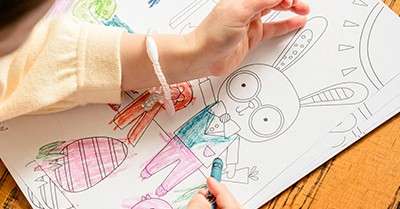A: While stencils can sometimes support fine motor skills and tracing practice, the EYLF and NQS place a strong emphasis on child‑directed, open‑ended experiences that nurture creativity, agency, and authentic expression. This means the real issue isn’t whether stencils are “wrong,” but how their use aligns with our responsibility to prioritise process art and ensure children’s voices remain at the centre of their learning.
What the Frameworks Say
-
EYLF & NQS don’t explicitly ban stencils. You won’t find a line that says “stencils are not allowed.”
-
However, the Guide to the NQS (Element 1.2.3 – Child Directed Learning) does highlight that assessors may look for open‑ended resources rather than templates or stencils “that limit the children’s capacity to create” (p.119).
-
The emphasis is on child agency, creativity, and authentic expression—values central to both EYLF and NQS.
Potential Benefits of Stencils
When used intentionally, stencils can:
-
Support fine motor development (grip, control, coordination).
-
Build confidence with pencils and tracing, laying foundations for writing.
-
Offer structure for children who enjoy pattern, repetition, or need scaffolding.
-
Be integrated into playful contexts (e.g., tracing shapes for a treasure map, decorating a collaborative mural).
Risks or Limitations
Over‑reliance on stencils can:
-
Restrict creativity and imagination by predetermining the outcome.
-
Undermine process art, where the focus is on exploration rather than the product.
-
Reduce opportunities for problem‑solving, decision‑making, and self‑expression.
-
Signal to assessors that practice is more adult‑directed than child‑led.
Balanced Practice
So, is anything “wrong” with stencils?
-
Not inherently. They can be valuable tools when used sparingly and purposefully.
-
The issue arises if they replace open‑ended, process‑driven art experiences.
-
Best practice in Australian early childhood settings is to prioritize process art and use stencils only as one of many resources, ensuring children’s creativity and agency remain central.
How Stencils Can Align With Process Art
-
Choice and agency: Place stencils among a variety of materials (paints, collage, loose parts, and markers). Children decide whether to use them, ignore them, or transform them.
-
Experimentation: A stencil can be traced, painted over, cut out, layered, or combined with other textures. The stencil becomes a starting point, not the end product.
-
Provocation: Educators can present stencils as an invitation (“What happens if you trace this shape and then paint over it?”) rather than a directive.
-
Integration: Stencils can be part of mixed‑media exploration; for example, tracing a shape and then turning it into something imaginative through collage or paint.
When Stencils Conflict With Process Art
-
If every child is expected to produce the same stencil‑based picture.
-
If the stencil dictates the “correct” outcome (colouring inside the lines, uniform products).
-
If they replace opportunities for open‑ended mark‑making, imaginative drawing, and self‑expression.
Yes, stencils can be used within process art, but only if they’re offered in ways that support exploration rather than restrict it.
Stencils aren’t prohibited, but they are limited. Our role is to champion process art as the foundation of creative practice, ensuring children’s voices, ideas, and agency remain central. This approach not only meets EYLF/NQS expectations but also nurtures the kind of rich, joyful learning experiences we want for every child.
Further Reading
Process Art Vs Product Art In Early Childhood Services
The Importance Of Drawing For Children In Early Childhood
Colouring Pages: Yes or No In Early Childhood Services?







 As an Educator in Australia, your pay rate falls under the Children’s Services Award 2010. This award states the minimum amount that an employer can
As an Educator in Australia, your pay rate falls under the Children’s Services Award 2010. This award states the minimum amount that an employer can When working as a qualified Early Childhood Teacher (with a university degree) within a service, your rate of pay will come from the Educational Services
When working as a qualified Early Childhood Teacher (with a university degree) within a service, your rate of pay will come from the Educational Services When working as a Diploma Qualified Educator your pay rate is from the Children's Services Award 2010. This Award states your minimum rate of pay
When working as a Diploma Qualified Educator your pay rate is from the Children's Services Award 2010. This Award states your minimum rate of pay When working as a Cert 3 Qualified Educator, your pay rate is from the Children's Services Award 2010. This Award states your minimum rate of
When working as a Cert 3 Qualified Educator, your pay rate is from the Children's Services Award 2010. This Award states your minimum rate of Educational Leaders play a crucial role in their early childhood service by ensuring that the educational program aligns with best practices and supports the holistic
Educational Leaders play a crucial role in their early childhood service by ensuring that the educational program aligns with best practices and supports the holistic In early childhood education and care, ratios are more than a technicality—they are a frontline safeguard. Every child deserves responsive supervision, emotional connection, and developmental
In early childhood education and care, ratios are more than a technicality—they are a frontline safeguard. Every child deserves responsive supervision, emotional connection, and developmental With the new national child safety reforms kicking in on 1 September 2025, early childhood services like yours have a real opportunity to lead the
With the new national child safety reforms kicking in on 1 September 2025, early childhood services like yours have a real opportunity to lead the Here’s a comprehensive Mobile Phone and Smart Watch Policy tailored for early childhood education and care (ECEC) services in Australia, aligned with the latest 2025
Here’s a comprehensive Mobile Phone and Smart Watch Policy tailored for early childhood education and care (ECEC) services in Australia, aligned with the latest 2025 The Sea of Fish Challenge is a national initiative that invites children, educators, families, and communities to create and display fish artworks as a symbol
The Sea of Fish Challenge is a national initiative that invites children, educators, families, and communities to create and display fish artworks as a symbol Across the early childhood education and care sector, educators are sounding the alarm: current staffing ratios are insufficient to deliver safe, meaningful, and developmentally appropriate
Across the early childhood education and care sector, educators are sounding the alarm: current staffing ratios are insufficient to deliver safe, meaningful, and developmentally appropriate


